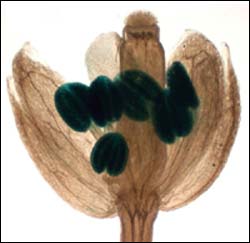Trapped genes show how flower development is controlled

Arabidopsis flower with specific gene active only in the stamen-anther.
Scientists at Yale and Cold Spring Harbor Laboratory report the first large-scale survey of patterns of gene expression in flowers, using the model plant Arabidopsis thaliana, to identify the genes most likely to have critical roles in plant reproduction.
The researchers studied 1765 lines and identified 80 genes active in petal and stamen development using “gene trapping.” In this gene discovery technique a reporter tag was inserted into cells so that they stained blue only when targeted genes were active. When an interesting developmental pattern was identified, the tagged gene was isolated and characterized.
These researchers studied Arabidopsis thaliana, a relative of the mustard plant, to take advantage of the already extensive genetic information available. Most familiar plants are flowering plants, so defining how flowering occurs in Arabidopsis thaliana can be used to understand this process in crops, weeds and trees.
“If a gene is turned on only in one type of tissue or organ within a flower, the chance is good that the gene has an important role in development of that organ. From this collection of patterns of gene expression, we can gain interesting insights about how gene activity is allocated during flower development,” said lead author Naomi Nakayama, a graduate student at Yale. “Understanding the process of flower development will help efforts to control aspects of plant reproduction like cross-pollination and seed production.”
“Our results show at what times and in which places genes are active,” explained Vivian Irish, associate professor of molecular cellular and developmental biology at Yale and senior author on the paper. “It is more than just a phone book of gene names; it tells us what these genes are doing. This is an excellent example of how modern molecular biology techniques help to increase our understanding of complex biological processes.
Collaborators included Juana M.Arroyo, Joseph Simorowski and Bruce May working with Robert Martienssen at the Cold Spring Harbor Laboratory. The research was funded with grant support from the National Science Foundation.
Media Contact
All latest news from the category: Life Sciences and Chemistry
Articles and reports from the Life Sciences and chemistry area deal with applied and basic research into modern biology, chemistry and human medicine.
Valuable information can be found on a range of life sciences fields including bacteriology, biochemistry, bionics, bioinformatics, biophysics, biotechnology, genetics, geobotany, human biology, marine biology, microbiology, molecular biology, cellular biology, zoology, bioinorganic chemistry, microchemistry and environmental chemistry.
Newest articles

Superradiant atoms could push the boundaries of how precisely time can be measured
Superradiant atoms can help us measure time more precisely than ever. In a new study, researchers from the University of Copenhagen present a new method for measuring the time interval,…

Ion thermoelectric conversion devices for near room temperature
The electrode sheet of the thermoelectric device consists of ionic hydrogel, which is sandwiched between the electrodes to form, and the Prussian blue on the electrode undergoes a redox reaction…

Zap Energy achieves 37-million-degree temperatures in a compact device
New publication reports record electron temperatures for a small-scale, sheared-flow-stabilized Z-pinch fusion device. In the nine decades since humans first produced fusion reactions, only a few fusion technologies have demonstrated…





















